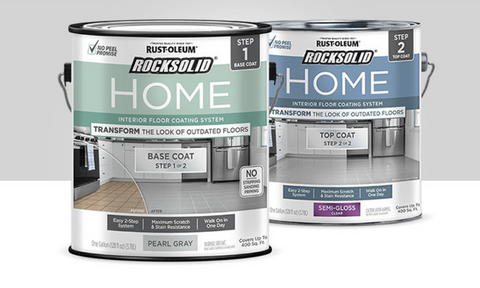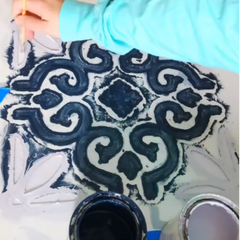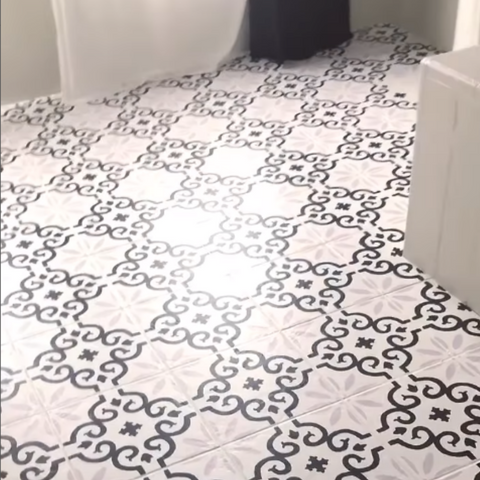How to Transform a Bathroom Floor using a Stencil
Stenciling existing floor tiles is an affordable alternative to replacing your bathroom floor.
Meet Alex who recently transformed her bathroom floor using Rust-Oleum floor paint and our Rissington Tile Stencil.
We will show you how she created this amazing transformation.
Rust-Oleum have brought out a range of paint that is extremely durable, easy to use, and allows you to paint your tiled floors without stripping, sanding, or priming them first. It is not only suitable for ceramic tile floors but also porcelain tiles, concrete, hardwood, laminate, vinyl, and more. Rust-Oleum Home floor paint set which includes a base and a top coat for your floors.

Start by painting the base coat around the masked off edges of the room where it is difficult to paint with a roller. Then use a roller (Recommend a 3/8 inch nap paint roller) to apply the base coat over the entire floor, working in sections as you paint yourself out of the room.
Top Tip: This base coat is the most important. Let this dry for 6 hours before doing anything else.
Most base coat colours only require one coat but Rust-Oleum recommend two coats if you are using the white base coat.

When you are happy with your colour combination it's time to start stenciling. Fix the stencil in place with masking tape before you start painting. Alex used a small paint brush to paint the separate colours of her stencil design. It might have been quicker for her to have had two stencils. One for each colour. Have the different coloured areas masked off and use a paint roller to apply each colour separately.
Top Tip: Always remove excess paint from your roller / brush before stenciling. Best to dab the roller / brush onto some kitchen paper or old newspaper to take off the excess paint. You never want to overload your brush / roller with too much paint as this causes the paint to bleed under the stencil.
A thick application of paint will bleed under the stencil, so its best to do thin coats that will give you nice clean lines.
In order to prevent the painted tiles from being smudged it is best to stencil every other tile, then once the paint is dry you can stencil the in between tiles. Remove the stencil whist the paint is wet and move onto the next tile. You could always use a hair drier to help speed up the drying time.
STEP 4 - TOP COAT
Top Tip: Allow the top coat to dry for 24 hours before any light foot traffic. Allow 72 hours before replacing furniture (and avoid dragging it on the floor). The floor will be ready for full use and fully cured after 7 days. You can then wash it using a non-abrasive general purpose cleaner.
Don't you agree that Alex did an amazing transformation. Simply by using paint and a stencil you can create a custom tile look without the custom tile price tag!
Lets just remind ourselves of how it looked before so we can see the drastic transformation. We think its amazing.

We think it's pretty amazing that with one tile stencil you can transform the look of a whole room. An amazing transformation.
All Photos are credited to Alex - Instagram - @everyday_styled
- See our full stencil collection here - Buy Stencils online (We ship worldwide).
- Follow us on Pinterest, Instagram and Facebook for more inspiration, stenciling fun and ideas.
- Share your own stenciling projects with us on Instagram or Facebook. We love to see your work.
Please feel free to comment below and share this post.
















Comments
Rev Ann Purdie said:
Absolutely gorgeous; I am going to TRY to do my bathroom; wish me luck